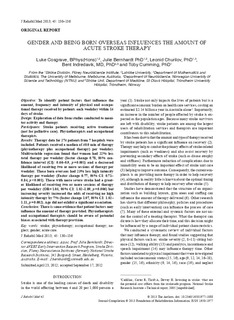Gender and being born overseas influences the amount of stroke therapy
Journal article, Peer reviewed
Published version
Permanent lenke
http://hdl.handle.net/11250/2621857Utgivelsesdato
2013Metadata
Vis full innførselSamlinger
Sammendrag
OBJECTIVE:
To identify patient factors that influence the amount, frequency and intensity of physical and occupational therapy received by patients each weekday within 14 days of stroke.
DESIGN:
Exploration of data from studies conducted to monitor activity and therapy.
PARTICIPANTS:
Stroke patients receiving active treatment (not for palliative care). Physiotherapists and occupational therapists.
RESULTS:
Therapy data for 274 patients from 7 hospitals were included. Patients received a median of 40.0 min of therapy (physiotherapy plus occupational therapy) per weekday. Multivariable regression found that women had 22% less total therapy per weekday (factor change 0.78, 95% confidence interval (CI): 0.66-0.9, p = 0.001) and a decreased likelihood of receiving two or more sessions of therapy per weekday. Those born overseas had 23% less high intensity therapy per weekday (Factor change 0.77, 95% CI: 0.71-0.84, p < 0.001). Those with more severe stroke had a greater likelihood of receiving two or more sessions of therapy per weekday (OR = 1.05, 95% CI: 1.02-1.09, p = 0.006) but increasing severity increased the odds of receiving no high intensity therapy by 7% (factor change 1.07, 95% CI: 1.02-1.11, p = 0.002). Age did not exhibit a significant association.
CONCLUSION:
There is some evidence that patient factors may influence the amount of therapy provided. Physiotherapists and occupational therapists should be aware of potential biases associated with therapy provision.
